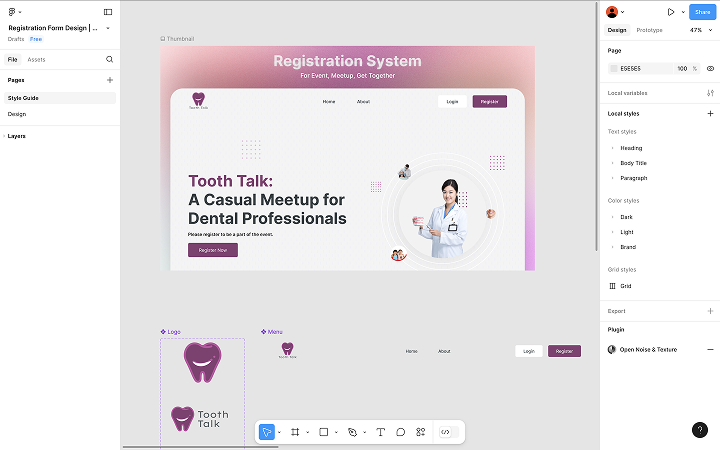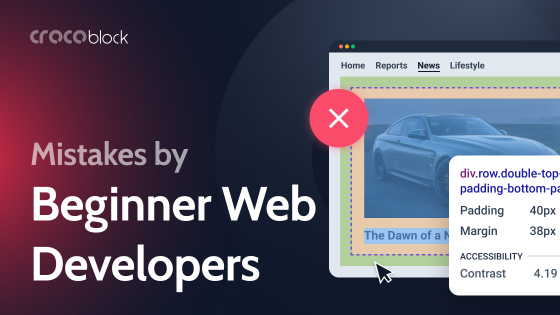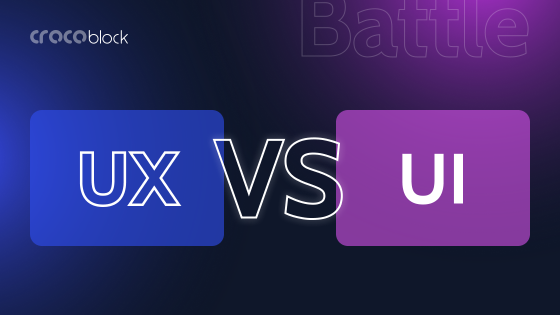When you’re hiring a professional or looking to learn a new design-related profession, you might think that a web designer and a web developer are the same. However, in reality, they have drastically different roles. So, what is the difference between web design and web development?
They are responsible for different areas of work, and the criteria for assessing their effectiveness also differ. Let’s dive into web designer vs. web developer differences.
Table of Contents
- What Is Web Design?
- What Is Web Development?
- Major Difference Between Web Design and Web Development
- FAQ
- Wrapping Up
What Is Web Design?
Web design is concerned with how the website functions and appears on the front end. It’s how a website looks, feels, and delivers the desired user experience that your brand should evoke to the end-user. It deals with a website’s color scheme, embedded media such as photos and videos, and shapes, among other things.
A web designer’s job is to effectively deliver the brand message and showcase the service through the company’s website. They’re responsible for ensuring optimal user experience using imagery, colors, and graphics. Web designers should also see that visitors can feel the brand personality through the website.
The main task of a web designer is to create a visually appealing website that attracts attention and encourages users to stay on the page as long as possible. It is also their responsibility to design a site that reflects the brand’s character and displays properly on different devices. They need to stay up-to-date with the latest trends and understand which shapes, fonts, and images to choose for a particular project.
Web designers essentially use their mockups to show website developers which elements should be placed in specific areas of the site.
In general, all designers can be divided into three categories:
- UX designers focus on providing the best user experience. They analyze audience behavior and create designs that align with user preferences, ensuring that people enjoy their time on the site.
- UI designers prioritize increasing user interactions with the site, such as button clicks and form submissions. Their goal is to make the interface engaging and functional.
- UI/UX designers create a flawless and visually appealing user experience. They combine UX and UI design responsibilities, balancing user needs with aesthetics and functionality, ensuring a product is both beautiful and easy to use.
- Product Designer has a broader role than a UI/UX designer. They focus not only on the user experience and interface but also on the product strategy, business goals, and development process.
To be a successful web designer, you should have the following skills:
- Creativity and problem-solving skills.
- Understanding typography, color theory, and composition.
- A solid understanding of design principles.
- Attention to detail and precision in execution.
- Critical thinking for finding solutions to usability and design challenges.
- Project management skills to handle multiple tasks efficiently.
- Knowledge of mapping out user flows and interactions before development.
- Creating engaging and interactive animated web elements for microinteractions.
What Is Web Development?
Web development is what makes a website actually work. It takes the design and turns it into a functional site using frameworks, CMS, or custom code. This includes everything from making sure buttons, forms, and interactive elements respond as expected to build the backend systems that store and process data.
In simple terms, if web design is about how a site looks, web development is about how it functions – both on the surface (front end) and behind the scenes (backend).
Web development could be split into two disciplines:
- Front-end development ensures that everything runs smoothly on the user’s part – buttons perform their intended functions, animations and pop-ups queue on time, and links bring the user where they need to go.
- Back-end development ensures everything runs smoothly for the website’s backend – the part clients can’t see. That deals with data-gathering systems and databases, as well as adequately integrating back-end employee-used software. That benefits your sales personnel, account executive, and data analyst.
Some developers are well-versed in both front-end and back-end web development. These are called full-stack developers.
Now, let’s explore the essential skills needed to become a proficient website developer:
- Proficiency in HTML markup, CSS, and JavaScript.
- Knowledge of programming languages like PHP, Python, and Ruby.
- Strong analytical skills for troubleshooting and optimization.
- Experience with content management systems (CMS) and eCommerce platforms.
- Creative problem-solving abilities.
- Familiarity with APIs and their integration.
- Strong project management skills.
- Ability to multitask and manage multiple projects efficiently.
Major Difference Between Web Design and Web Development
The roles of web designer and web developer are often blurred, particularly with the rise of no-code solutions, plugins, and website builders. Tools like Elementor, Webflow, and various content management systems allow individuals to take on both design and development tasks. However, there are distinct differences between the two roles. It’s useful to think of them on a spectrum: at one end, you have web development, at the other, web design, and somewhere in between, a website developer who may handle both design and development responsibilities.
Web developer: a broader role
A web developer is a more general term that covers the development of not just websites but also web applications, web services, server-side logic, APIs, and other web-based solutions. They may work on either the front-end (what users see) or back-end (server-side) aspects of a website. In the context of WordPress, for instance, web developers are the ones who can create custom plugins or code unique solutions. They typically don’t focus on design but instead work on implementing complex technical solutions. For such projects, a professional design team is usually required, with clearly defined roles and processes.
Website developer: a more focused role
The term website developer is narrower and specifically refers to the development of websites. This role may involve coding in languages like HTML, CSS, JavaScript, PHP, and others, or working with CMS platforms like WordPress, or website builders such as Webflow.
A website developer might be someone who uses tools like Elementor to assemble a website. Often, people in this role are familiar with basic design principles, especially if they’re working on smaller websites that need to attract customers. These developers might even refer to themselves as “website creators.” However, without knowledge of design principles, their work could lack visual appeal and clarity. Freelancers who create websites “from scratch” often fall into this category. Many of them even call themselves website designers, though they don’t necessarily possess deep knowledge of design. UI/UX design, on the other hand, is a more professional and specialized level of design.
UI/UX designers: specializing in user experience and visual design
UI/UX designers are professionals who specialize in the visual style and usability of websites and apps. They focus on the user experience and user interface, applying principles to ensure a seamless, intuitive interaction. These designers work not only on websites but also on digital products like apps, dashboards, and SaaS systems. While UI/UX designers focus primarily on usability and aesthetics, a product designer takes on a broader role, overseeing the entire lifecycle of a product.

Product designer: the top-level role
A product designer can be considered the top level in web design, but their role is much broader. Unlike a web designer, who primarily focuses on the visual appearance of a site, a product designer manages the entire product lifecycle – from concept and development to continuous improvement. They don’t just focus on design but also consider the user experience, business goals, and technological possibilities. They collaborate with development teams, marketers, analysts, and others, using data and research to guide the design process. Essentially, a product designer combines everything: design, UX, business strategy, analytics, and product development, making it a much more expansive role than that of a web designer.
FAQ
A web designer focuses on a website’s visual and user experience aspects, ensuring it looks appealing and aligns with the brand. A web developer builds the website’s functionality through coding, making sure everything works as intended.
Yes, some professionals are hybrid web designers and developers, meaning they can design and code websites. However, for complex projects, it’s often best to have separate specialists for each role.
A web developer is responsible for optimizing website speed and performance. They ensure fast loading times, uptime, and error-free functionality by using efficient coding and server management techniques.
Wrapping Up
There are many differences between web designers and developers.
A web designer builds the website design, deciding on its layout and color palettes and ensuring an optimal website UX/UI. A web developer manages your site’s coding and back-end systems development, bringing the digital product to life.
Web designers don’t need coding knowledge, but web developers do. Web designers tend to be more creative, concerning themselves with a website’s visual appeal. Web developers tend to be more technical, concerning themselves with the systems that make a website functional.
Now that you know the difference between a web designer and a web developer, you’ll be better positioned to know which one you need for your business.

